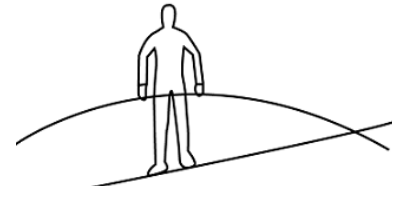
A tightrope walker in a circus holds a long flexible pole to help stay balanced on the rope. Holding the pole horizontally and perpendicular to the rope helps the performer
(A) By lowering the overall centre-of-gravity
(B) By increasing the rotational inertia
(C) In the ability to adjust the centre-of-gravity to be over the rope.
(D) In achieving the centre of gravity to be under the rope.


Answer
430.8k+ views
Hint : In order to solve this question, we are going to first see the phenomenon of the balancing of the person over the rope and the alignment of the pole in the hands of the ropewalker. After that the correct options out of the four options given in the question are chosen.
Complete Step By Step Answer:
In order to balance himself on the rope, the ropewalker needs to align the centre of mass and the centre of gravity should locate in a line over the support point i.e. the rope.. Hence, if the pole is held horizontally and perpendicular to the rope, this helps the performer to make balance by increasing the rotational inertia and the ability to adjust the center – of –gravity to be over the rope.
Thus, holding the pole horizontally and perpendicular to the rope helps the performer by increasing the rotational inertia and in the ability to adjust the centre-of-gravity to be over the rope.
Hence, options (B) and (C) are the correct answer.
Note :
The smaller moment of inertia means that there is a less resistant force of rotation. In order to achieve the rotational equilibrium, some rapid corrections have to be made. However, the moment of inertia can be increased by stretching the hands outside standing on the rope to make the balance.
Complete Step By Step Answer:
In order to balance himself on the rope, the ropewalker needs to align the centre of mass and the centre of gravity should locate in a line over the support point i.e. the rope.. Hence, if the pole is held horizontally and perpendicular to the rope, this helps the performer to make balance by increasing the rotational inertia and the ability to adjust the center – of –gravity to be over the rope.
Thus, holding the pole horizontally and perpendicular to the rope helps the performer by increasing the rotational inertia and in the ability to adjust the centre-of-gravity to be over the rope.
Hence, options (B) and (C) are the correct answer.
Note :
The smaller moment of inertia means that there is a less resistant force of rotation. In order to achieve the rotational equilibrium, some rapid corrections have to be made. However, the moment of inertia can be increased by stretching the hands outside standing on the rope to make the balance.
Recently Updated Pages
Glucose when reduced with HI and red Phosphorus gives class 11 chemistry CBSE

The highest possible oxidation states of Uranium and class 11 chemistry CBSE

Find the value of x if the mode of the following data class 11 maths CBSE

Which of the following can be used in the Friedel Crafts class 11 chemistry CBSE

A sphere of mass 40 kg is attracted by a second sphere class 11 physics CBSE

Statement I Reactivity of aluminium decreases when class 11 chemistry CBSE

Trending doubts
10 examples of friction in our daily life

One Metric ton is equal to kg A 10000 B 1000 C 100 class 11 physics CBSE

Difference Between Prokaryotic Cells and Eukaryotic Cells

State and prove Bernoullis theorem class 11 physics CBSE

What organs are located on the left side of your body class 11 biology CBSE

How many valence electrons does nitrogen have class 11 chemistry CBSE




